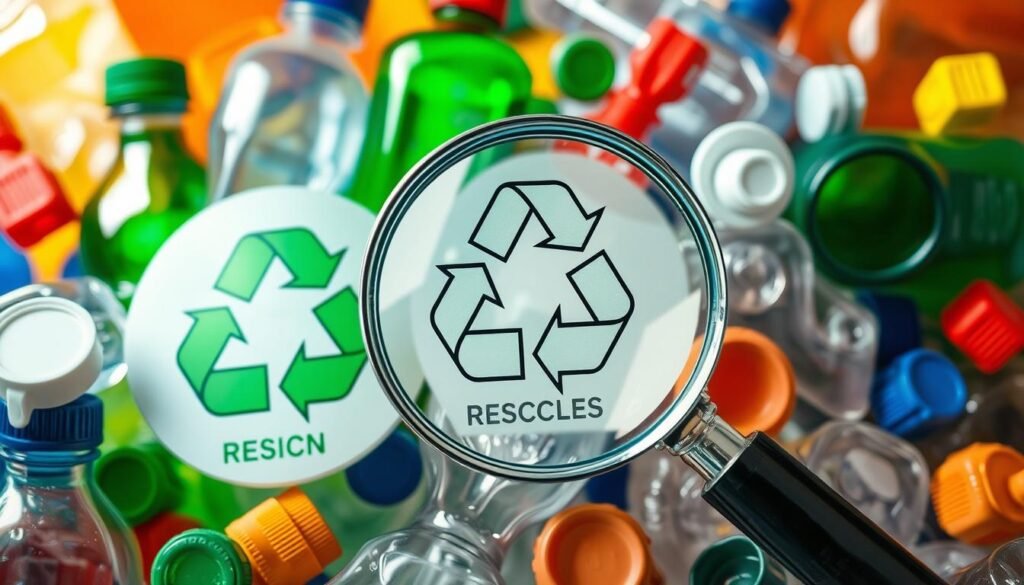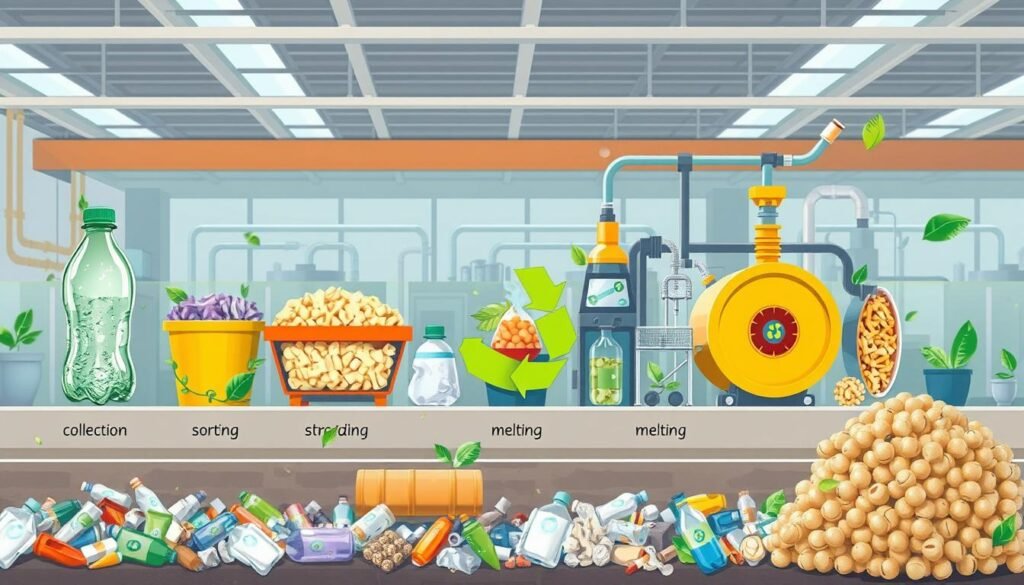At the center of sustainable recycling is a key system for understanding recycling symbols. The system uses resin identification codes. These plastic recycling numbers appear within the triangular arrow symbol on plastics. They are crucial for environmental care in managing materials. As big supporters of the environment, we aim to clear up what these numbers mean. We help industrial business owners and tech experts make smart recycling choices.
Codes range from #1 to #7, each marking a different plastic type. But, recycling them is not always straightforward. #1 (PETE) and #2 (HDPE) are the most commonly recycled. You find them in things like drink bottles and soap containers. These materials fit well into most recycling programs. They help us move toward better waste management. Yet, plastics #3 to #7 can be harder to recycle. We have technology and innovative solutions to face these challenges.
Local rules can change what you can recycle. For instance, Massachusetts bans tossing out certain plastic bottles in the garbage. Meanwhile, types 1 and 2 plastics usually go into the recycling bin without issue. It’s key to know and follow these local rules. Working together with local recycling programs is important. It helps us all do our part for a greener future.
Decoding the Recycling Symbol: A Guide to Resin Identification Codes
To understand plastic recycling, knowing the resin identification code is key. These codes appear inside the recycling symbol. They guide us through the recycling process. From #1 PET or PETE in water bottles to #7 for various resins, each code tells us about the plastic’s type and recyclability.

Learning about recycling symbols means more than just knowing what they represent. It’s about using that knowledge to recycle better. The details in these symbols are crucial because they affect what recycling programs will accept. For instance, #1 (PET) and #2 (HDPE) are mostly accepted everywhere, but #3 (PVC), with its phthalates, can be dangerous and is often not recycled.
It’s important to match each resin code with your local recycling rules. Doing this ensures the right plastics get recycled. This is not only good for the planet but helps keep recycling systems effective and safe.
| Resin Code | Type of Plastic | Common Usage | Curbside Recyclability |
|---|---|---|---|
| #1 PET/PETE | Polyethylene Terephthalate | Water and soda bottles | High |
| #2 HDPE | High-Density Polyethylene | Milk jugs, laundry detergents | High |
| #3 PVC/V | Polyvinyl Chloride | Food wrap, plumbing pipes | Low |
| #4 LDPE | Low-Density Polyethylene | Shopping bags, bread bags | Increasingly accepted |
| #5 PP | Polypropylene | Yogurt containers, straws | Moderate |
| #6 PS | Polystyrene | Disposable coffee cups, packing foam | Low |
| #7 Others | Miscellaneous Plastics | Mixed plastic items | Very Low |
Offering advanced recycling solutions means teaching about resin codes. By knowing these codes, both people and companies can make recycling more effective. This supports our environment and business goals.
Most Common and Most Recyclable: PETE and HDPE
PETE and HDPE are key in recycling. They’re used a lot and are great for recycling. This helps us fight plastic waste.
Understanding PETE (Polyethylene Terephthalate)

PETE recycling is a big win for the environment. It’s widely accepted around the globe. It’s used in things like drink bottles and food containers.
Then, PETE gets turned into RPET, a better recycled material. RPET is used in clothes, carpets, and car parts. This shows PETE’s huge role in eco-friendly and cost-saving products.
The Versatility of HDPE (High Density Polyethylene)
HDPE recycling is key to lessening our environmental footprint. It’s found in milk jugs, shampoo bottles, and more. Recycled HDPE becomes things like plastic lumber and containers.
This process turns it into durable items like pipes and recycle bins. HDPE’s reusability promotes a world where recycling is central.
Emphasizing PETE and HDPE recycling can reduce environmental harm. Better recycling systems save resources and support sustainable making. Using these materials well is vital for our planet’s future.
Challenges in Recycling: PVC, LDPE, and PS
We get that recycling plastic, especially types like PVC, LDPE, and PS, is tough. But we’re dedicated to finding ways through these troubles. We’re facing off against the special problems each of these materials brings.
PVC recycling is hard because of the chlorine and harmful additives it has. It needs complex methods to make it safe again for use. Yet, PVC that’s recycled can last nearly 600 years, making the struggle worth it for our planet’s future.
LDPE film separation is slowed down by having to sort the films by type and color. This step is key to making the recycling worth it. Our aim is to make the LDPE recycling process better. We want to deal with its light and bendy nature more efficiently.
PS recycling challenges are mainly due to it being mostly air. This makes PS both light and bulky, causing issues with gathering, squishing, and moving it. Improving these steps is our focus, to make recycling polystyrene cheaper and doable on a bigger scale.
- PVC must be processed separately to remove harmful additives.
- LDPE requires meticulous sorting to maximize recycling outputs.
- Polystyrene needs compacting technologies to reduce its volume for effective recycling.
The world really needs better recycling methods. As of 2019, we made 353 million tons of plastic waste. And every minute, it’s like dumping a whole truck of plastic into the sea. So, finding good ways to recycle is super important.
Trying out new, clean tech and recycling ideas supports the fight against plastic pollution. Experts think we can cut plastic trash by 80% by 2040 if we all work together. Getting better at recycling PS, PVC, and LDPE is key for our environment.
We’re fully focused on overcoming these recycling obstacles. Our team is pushing research and new solutions to make recycling sustainable. It’s about being innovative and also caring for the earth so the future looks bright for everyone.
Emerging Trends in the Recycling of PP and Other Plastics
The world of recycling is changing quickly, especially with PP recycling process and sustainable plastic solutions. Efforts to recycle polypropylene (#5) and manage the complex #7 plastics are increasing. We aim to improve these processes to help our planet.
Growth of Polypropylene Recycling Efforts
The last few years have seen a jump in polypropylene recycling efforts. Better technology and a bigger market for recycled stuff have changed the game. For example, APR recycler members managed to recycle 5 billion pounds of plastics last year. This shows we’re getting better at recycling.
- Polypropylene is a big part of our plastic packages, along with PET and HDPE.
- Its ability to be reused in many products, like car parts and tools, is why PP recycling process is getting more attention.
- The APR PCR Certification Program makes sure recycled materials are really from consumers. This helps companies be more sustainable.
Understanding #7 Plastics and Recycling Complications
#7 plastics are a mixed bag, including tough cases like polycarbonate recycling and sorting mixed plastics recycling. They’re hard to recycle because of their different makeup and lack of consistency.
- A recent study shows that polycarbonate recycling could work with chemical recycling. This new method breaks plastics down to their building blocks.
- Most mixed plastics don’t get recycled due to big challenges. Only a little bit gets processed the right way.
- Efforts like the U.N. Global Plastic Pollution Treaty aim to fix these issues. They want tougher rules for plastic waste worldwide.
With new ideas and constant effort, we believe the PP recycling process can get better. We also need to solve problems with #7 plastics. Our goal is sustainable plastic solutions. We want to make sure plastics are reused and don’t harm our environment.
Conclusion
Understanding plastic recycling numbers is crucial for environmental sustainability. It’s not just about being eco-friendly. It involves managing plastic disposal and creating new recycling methods. Despite recycling efforts, many plastics like PVC and polystyrene are hardly recycled, harming the environment.
We need to increase recycling rates and cut down on plastic production. This includes using less harmful materials and recycling more HDPE into useful products. Informed decisions and progressive policies are vital, particularly in places with low recycling rates like Colorado. Considering the entire lifecycle of plastics is essential for creating sustainable solutions.
Achieving an eco-friendly future requires educating the public, improving recycling infrastructure, and investing in sustainable material research. By confronting challenges like low recycling rates and the push for new plastic production, we can promote growth. This approach benefits the industry, communities, and the planet.
FAQ
What do the plastic recycling numbers represent?
Plastic recycling numbers are resin identification codes. They categorize plastics by polymer type. This helps in recycling and proper disposal. For example, #1 (PETE) and #2 (HDPE) are often recycled. But, some types might not be recycled everywhere.
How can I decode the recycling symbols on plastic products?
Decoding recycling symbols is about understanding the resin code. The code is inside a triangle of arrows. It shows the plastic type used. Each number corresponds to a different material. This affects how it can be recycled.
Why are PETE and HDPE considered the most recyclable plastics?
PETE and HDPE are the most recycled types. They’re widely accepted in programs and easy to process. PETE, found in drink bottles, turns into RPET.
HDPE is in products like shampoo bottles. It gets recycled into newer items, such as plastic lumber.
What challenges are associated with recycling PVC, LDPE, and PS?
Recycling PVC is hard due to chlorine and harmful additives. It needs special processing. LDPE’s value drops when separated by type and color. PS is tough to recycle as it’s lightweight and bulky, raising transport and processing costs.
How is polypropylene recycling evolving?
Polypropylene recycling is growing. More recycling programs now accept it. The process involves collection, sorting, and melting. Thus, PP can be made into new products like car parts and garden tools. This promotes sustainable plastic use.
What are the complications with recycling #7 plastics?
#7 plastics vary, like polycarbonates and resin mixes. Their diversity complicates recycling. Mixed materials can be weaker. While some #7s can be chemically recycled, often, they’re hard to process.
Are all plastics with a recycling symbol accepted for curbside recycling?
Not every plastic with a recycling symbol is accepted curbside. Local rules and recycling center capabilities differ. Always check local guidelines for proper plastic disposal and recycling.
How can I ensure I’m recycling plastics correctly?
To recycle right, start by identifying the plastic type via the resin code. Then, see what your local program accepts. Clean and sort your plastics as required. Try using less plastic to reduce waste overall.
